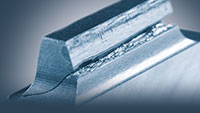
Flank Fracture
Damage pattern - mechanisms - influencing factors - calculation approaches
Introduction
The load carrying capacity of the tooth flank and root are crucial gear dimensioning parameters. Optimized design and continuous improvements to the simulation process have made it possible to largely avoid the "classic" fatigue damage symptoms of pitting and tooth root fracture as well as to increase the load carrying capacity limits of gears. However, this leads to an increased risk of damage due to the formation of cracks at great component depths. Flank fracture is characterized by cracks originating beneath the surface of the tooth flank. Damage due to flank fracture generally occurs suddenly and unexpectedly due to growth of the crack within the material. The consequences are generally serious and often result in complete failure of the affected gear stage. Outages due to flank fracture therefore lead to high repair and downtime costs. To avoid damage due to flank fracture, it is important to know and understand the underlying mechanisms and influencing factors.
Target Audience
Employees from companies and specialist departments for spur and bevel gear units: design and operating engineers, maintenance and repair specialists, experts.
Main Topics
The following topics will be covered:
- Damage pattern of flank fracture - basics and damage characteristics
- Mechanisms and influencing factors of flank fracture
- Calculation methods for flank fracture risk
- Exemplary calculation study (variation calculations)
Objectives
The goal of the seminar is to provide a deeper understanding of the mechanisms, influencing factors, and simulation processes for flank fracture on gears:
- Reliable detection and assessment of damage to spur, bevel, and hypoid gears due to flank fracture
- Knowledge of the essential mechanisms and relevant influencing factors of damage due to flank fracture
- Knowledge of calculation methods for a quantitative evaluation of the risk of flank fracture
- Understanding of the advanced interpretation of calculation results for qualitative and quantitative estimation of the possibilities for avoiding flank fracture
Instructors
Dr. Thomas Tobie
Technical University of Munich, Gear Research Centre (Forschungsstelle für Zahnräder und Getriebebau, or FZG)
